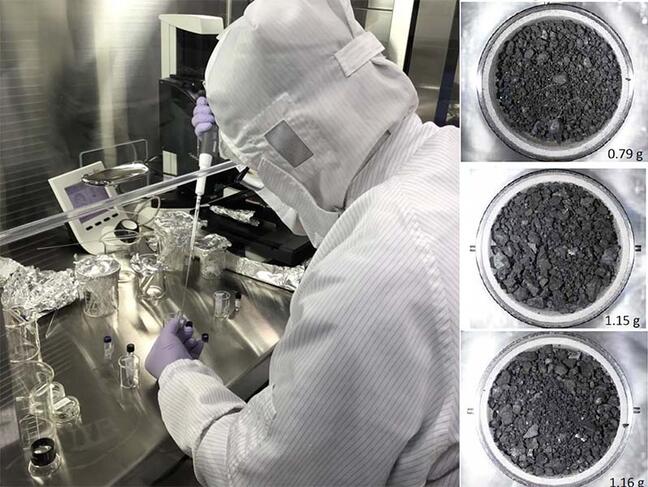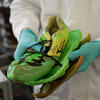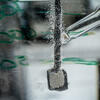You are here
Astrochemistry, inside cosmic kitchens

Born in the late 1930s with the development of spectroscopy and radio astronomy, astrochemistry, a field at the intersection of astrophysics and chemistry, is now mature. New means for observing the sky using infrared and radio have increased its capacity to remotely detect molecules in space, while the trove of information sent by the probes crisscrossing the Solar System—and advances in instrumentation—have provided it with the tools needed to test its hypotheses through realistic experiments.
“The interstellar environment is not made up of a vacuum,” reveals Grégoire Danger, an academic at the Physics Laboratory of Ionic and Molecular Interactions.1 In regions of star formation, the opposite would even be true. Frozen in the darkness at temperatures between -253 °C and -263 °C are large clouds consisting of 99% molecular hydrogen and volatile trace elements. When reacting with the atoms adsorbed at the surface of micrometre-sized dust grains circulating in these environments, these gases enable the formation of ice made of water, ammonia, carbon dioxide, methane, and methanol. Under the influence of cosmic rays, they are then loaded with other chemical compounds such as carbon monoxide and formaldehyde, with over two hundred gas and solid species being known.

These giant structures later collapse onto themselves and give birth to stars and planets that, by accreting the surrounding gas, allow light to circulate freely and heat the superficial layers of the “lumps” of matter in orbit, such as comets and other asteroids. This “photolysis” sparks a new chemical chain reaction leading to the appearance of even more complex molecules. These icy and rocky bodies, which are too small to be totally modified by their internal heat, massively bombarded the Earth four billion years ago, which is why one well-known hypothesis posits that they provided the building blocks for the appearance of life on Earth.
Analogues of extraterrestrial ice
What are these building blocks? And in what quantity do they exist? That is what Grégoire Danger and his colleagues are trying to determine by synthesising avatars of extraterrestrial ice. “The researchers place a mix of water, ammonia, methane, and carbon dioxide under the temperature and pressure conditions present in space, in order for them to condense around substrates imitating dust grains, aerosols, and meteorites,” Danger explains. They then irradiate and heat these surfaces, using among others UV rays like those emitted by stars to produce residues akin to those found in molecular clouds–such as Jupiter’s moon Europa, and Saturn’s moon Titan–and when gradually increasing light intensity, even those found in the nucleus of a comet approaching the Sun. They thereby create samples containing tens of thousands of different species of organic molecules, including sugars and amino acids, from the same family as those that make up the DNA and RNA proteins of living beings.
In her laboratory at the Institute of Chemistry of Poitiers: Materials and Natural Resources,2 Pauline Poinot and the team have adapted the tools of biology to the processes used in high resolution mass spectrometry and chromatography in gas and liquid phase, successfully demonstrating that a compound as complex as cytosine–one of the five nucleotide bases that make up strands of DNA and RNA–was synthesised in the nebula from which the Solar System emerged!
And that is just the beginning. With the launch in 2025 of the MIRRPLA platform,3 in connection with the Origins Priority Research Programme and Equipment,4 these specialists will soon be able to combine UV rays with electron and ion beam irradiation of ice, with a view to simulating the effect that cosmic rays have on this space chemistry. This is a world first, although Danger points out that precisely reproducing the reactions involved in the emergence of life on Earth is not the objective. “The probability of tracing this history back in time is almost zero. Especially as the emergence of life did not result from an accumulation of complex molecules on our planet, but from their selection, replication, and evolution in a proto-Darwinian manner. In other words, through a self-organisation of matter, and a chemistry based on ‘self-catalytic’ systems about which we no practically nothing.”
It is this path that Danger and Poinot plan to explore, the former by developing microfluidic reactors, in which solutions under primitive Earth conditions could be tested, and the latter by developing analysis methods. “This will involve using statistical data processing to detect within samples the reactions of self-replication and self-organisation that are characteristic of living beings,” Poinot clarifies.
A distinctive feature of living beings: homochirality
Living beings possess at least one known property: homochirality. Numerous biological molecules are said to be “chiral.” They can exist in two dissymmetric versions known as “enantiomers,” which are perfectly identical, except that they are a non-superimposable mirror image of one another, like our two hands. However, as we have known since Louis Pasteur’s work in the nineteenth century, most of the amino acids that make up the proteins and peptides that living beings use are left-leaning or “levogyre,” which is to say they tend to deflect polarised light to the left. On the contrary, the sugars found in DNA are right-leaning, or “dextrogyre.” This is strange, for when synthesised in the laboratory, these chiral molecules are produced in equal quantity in both conformations.

Why these preferences? And how to explain that on Earth, these compounds actually exist in just a single variant? It is this question that interests Uwe Meierhenrich, the Director of the Nice Institute of Chemistry5. He has devoted his entire career to developing, along with his colleagues, analytical methods for separating the enantiomers in hydrocarbons, alcohols, amino acids, and many other families of molecules. Among others, his team has developed an enantioselective gas chromatographic process, which earned him an invitation from the European Space Agency (ESA) to take part in the Rosetta mission (2004-2016) exploring the 67P/Tchourioumov-Guérassimenko comet.
Installed on the COSAC instrument on board the Philae lander, with which the probe was equipped, the chromatograph coupled with a mass spectrometer was supposed to measure the chirality of the object’s surface molecules. In line with certain theories, supported by laboratory experiments positing that the Sun produced a limited form of asymmetry at the time of its formation, the scientists hoped to gather information by studying this primordial star, where Rosetta would ultimately detect the presence of the amino acid glycine.
Unfortunately, Meierhenrich recounts, “during its arrival on 12 November 2014, Philae bounced multiple times before coming to a stop against a rock in an inclining position. COSAC identified a dozen organic molecules, but was not able to collect enough material to measure enantiomers.”
This development could have discouraged these chemists if it had not, on the contrary, served as a springboard for another project: sending an experiment to the red planet as part of the ESA’s exo-Mars 2028 mission. Scheduled for 2028, it will include a rover named Rosalind Franklin that will analyse samples of Mars subsoil for the first time. It will do so using the Moma instrument, which includes a gas chromatograph that can separate enantiomers. There is much at stake, explains Meierhenrich, “because if strong asymmetry were detected on certain chiral molecules such as hydrocarbons, this would provide a serious indication that some form of life existed on Mars in the distant past!”
Return of samples
Meteorites are another source of data for astrochemists, as long as they were not contaminated or transformed during their arrival on our planet, and we are able to associate them with the families of celestial bodies identified by astronomers. Francois-Régis Orthous-Daunay of the Institute for Planetary Sciences and Astrophysics in Grenoble,5CNRS/Université Paris Saclay. and Roland Thissen, of the Paris-Saclay Institute of Physical Chemistry,6 have looked more closely at the problem by developing an IT tool that can analyse the data of mass spectrometers. These instruments identify the composition of samples by separating their constituent parts according to their weight, Thissen elaborates, and then “ultimately obtaining a spectrum where each of the thousands of peaks represents a particular species of molecule.”

How to sift through it all? The team developed software that can classify these signals by chemical family. It used this expertise to analyse, for the first time, samples of the asteroid Ryugu brought back to Earth in 2020 by the Japanese mission Hayabusa 2. The results appeared in two articles published last year in the journal Science7,8. One revealed the presence within this object of certain polycyclic aromatic hydrocarbon (PAH) molecules dating from before the appearance of the Solar System. The other established the similarity between the composition of the celestial body, which is rich in amino acids, and that of a meteorite that fell in Tanzania in 1938. This once again confirms that studying the chemistry of Solar System objects is one of the keys to understanding the origin of life on Earth.
- 1. CNRS-Aix Marseille Université.
- 2. CNRS/Université de Poitiers.
- 3. Multiple-beam IRRadiation PLAtform.
- 4. CNRS/Université Côte d’Azur.
- 5. CNRS/Université Grenoble Alpes.
- 6. CNRS/Université Paris Saclay.
- 7. https ://www.science.org/doi/full/10.1126/science.abn9033
- 8. https://www.science.org/doi/abs/10.1126/science.adg6304(link is external)


















